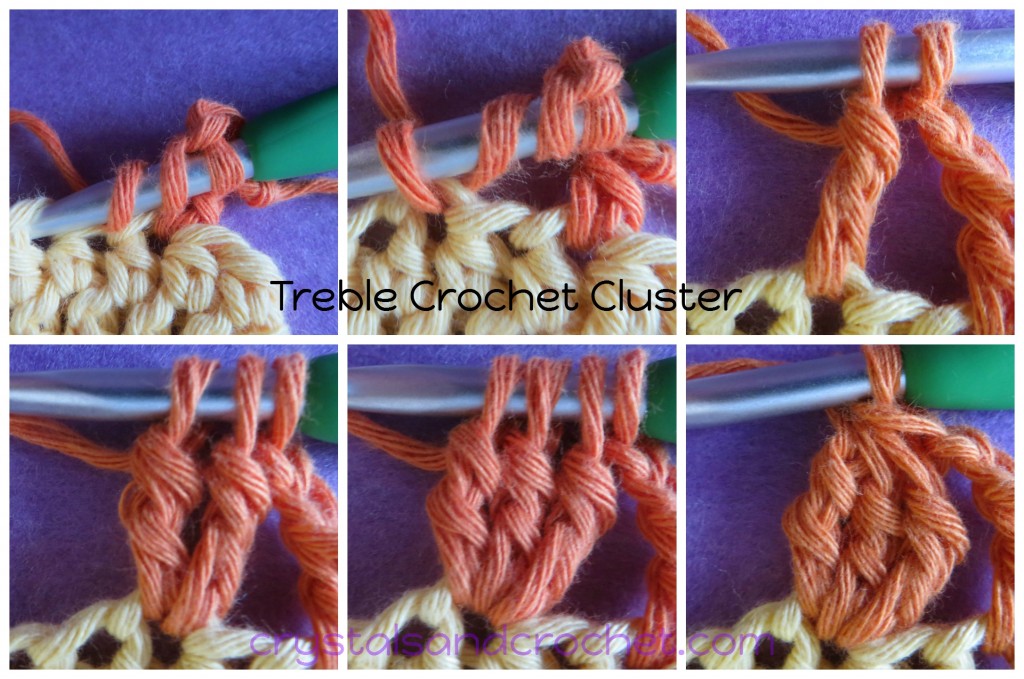Sign Up
Already have an account? Sign in here
Sign In
Dont have an account? Sign up here
Clusters & Working Stitches Together

Clusters, are stitches where two or more stitches are worked together.
They are mainly used as decorative stitches but working stitches together [tog] is also used to decrease the number of stitches in a row or round.
Clusters
A cluster is a group of stitches joined closely together at the top and bottom, or sometimes at the top only.
Where the stitches are joined top and bottom the pattern will normally have the details in the “Special Stitches” section and may be abbreviated as [cl].
Where the stitches are joined at the top only it will often be referred to as [tog], eg: dc3tog.
When making clusters the last yarn over and pull through 2 loops is omitted, giving a partial stitch.
To make a dc cluster:
When making a dc cluster you will be making half a stitch [partial dc] for each stitch and then yarn over and pull through all loops on hook to complete all of the stitches at the same time.
Yarn over, put hook through indicated stitch, yarn over and pull through two.
Two loops on hook.
Again, yarn over and pull through two.
Three loops on hook.
Again, yarn over and pull through two.
Four loops on hook.
Yarn over and pull through all four loops to complete the stitch.

To make a “starting” treble cluster:
Make a standing tr, but omit the last yarn over and pull through two [partial standing treble].
Two loops on hook.
Make another two tr, omitting the last yarn over and pull through two.
Four loops on hook.
Yarn over and pull through all four loops, to close the cluster.
A starting or beginning cluster can also be started with ch 3 for tr cluster or ch 2 for dc cluster.

To make a tr cluster:
When making a tr cluster you will be making two thirds of a stitch [partial treble] for each stitch and then yarn over and pull through all loops on hook to complete all of the stitches at the same time.
Yarn over twice, put hook through indicated stitch, yarn over and pull through two, yarn over and pull through two.
Two loops on hook.
Again, yarn over and pull through two, twice.
Three loops on hook.
Again, yarn over and pull through two, twice.
Four loops on hook.
Yarn over and pull through all four loops to complete the stitch.

As you can see with the clusters they are made into one stitch and there is one stitch at the top, no change in the number of stitches in the row or round.
With the [tog] stitches you will see that there are multiple stitches at the bottom but only one stitch at the top, thus decreasing by one or more stitches.
To make a sc2tog:
Hook through indicated stitch and pull up a loop, repeat in next stitch, yarn over and pull through all three loops on hook.
Decrease of one stitch.

To make a dc3tog:
Yarn over, put hook through indicated stitch, yarn over and pull through two.
Two loops on hook.
In next stitch, yarn over and pull through two.
Three loops on hook.
In next stitch, yarn over and pull through two.
Four loops on hook.
Yarn over and pull through all four loops to complete the stitch.
Decrease of two stitches.



A handy hint….
When working more than one group of stitches together to decrease, fold your work over to avoid stretching the top loops of your stitches, and maintain a much neater look to your work.
Another handy hint…..
When working large groups of stitches together, as with Catherine Wheel or Starburst stitches, especially if you are working with thicker yarns, using a tunisian hook can make it easier to keep all your stitches on your hook.


♥ All of my tutorials are free and are written or recorded using US terminology.
♥ If you need help and advice, the quickest way to find support is to join Helen’s Hookaholics Facebook group. There you will find a very supportive group of likeminded people. It’s also a great place to share your crystalsandcrochet makes, and see what others are making, and see what I am up to.
♥ If you are not a fan of Facebook you can always email me with any questions you may have by using the contact form here.




